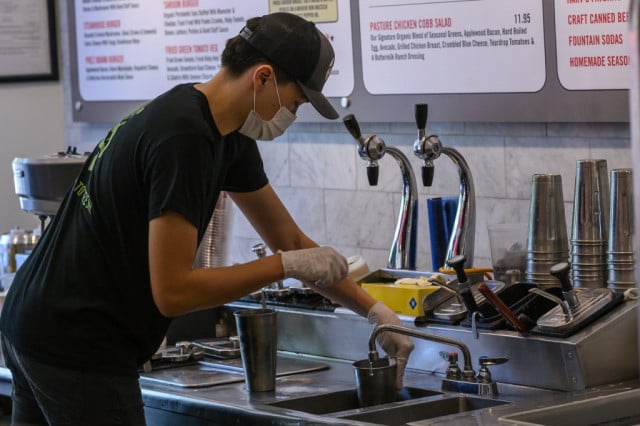Pandemic pushes poor US students into working odd jobs

- By Agence France-Presse (AFP)
- June 9, 2021 9:43 AM
Arlington, United States | When his father lost his job last year, Togi, then 16, wasted little time before looking for work to support his family, even though he knew it could put him at risk of contracting Covid-19.
He ended up working at a fast food restaurant in a suburb of Washington, juggling the job with online classes as the world's largest Covid-19 outbreak tore through the United States.
"It's exhausting," Togi said, describing long days spent between school and work, leaving little time for the teenager to socialize.
The twin health and economic crises caused by the pandemic in the United States have forced some teenagers to take on odd jobs, mostly in the fast food industry, to help their families while trying to keep up with the demands of virtual schooling.
Educators say many students have fallen off the radar, and may not return to classrooms when in-person learning resumes as the pandemic ebbs.
Most students who have gone to work are Black or Hispanic -- "communities that were disproportionately affected by the pandemic, both in the numbers of infections and deaths," said Elmer G. Roldan, executive director of Communities In Schools (CIS) of Los Angeles, which works to stop young people from dropping out.
Students from families whose parents are undocumented and not able to access government relief measures enacted during the pandemic also are also facing pressure to work, he said.
- No choice -
There are no official statistics for how many students may end up leaving school to work.
Hailly Korman, a senior associate partner at Bellwether Education Partners, which is focused on improving schooling, said some students have simply been unable to avoid working, after parents or caregivers lost work due to the virus.
"These kids are not working because that's fun, or they're making lots of money. They're working because they have financial needs that need to be met," she said.
"And if the choice is go to work, or your family is out on the street, that's not a choice at all."
Teachers and professionals in the CIS network have said the number of high school students working has increased dramatically during the pandemic, and the hours of those who already were working has increased to as much as 35 hours a week.
"Legally, students are supposed to work no more than 20 hours if they are working part time," but in practice, "it's hard to monitor," Roldan said.
Johanna, a high school student in Los Angeles, began working in a fast food restaurant when she was 17, balancing the job that pays around $450 a week, with her online classes.
She sometimes stays up until midnight to finish work, with only Wednesdays and Saturdays off, but says she remains intent on finishing her studies.
"I know if I drop out of school... I'm just going to keep working at a restaurant," said Johanna, who hopes to be a music therapist.
Yet Korman says many working students will not be able to hold on.
"What we've done is created an environment where the decision to leave school to work feels even easier," she said.
Hardest hit are students who were struggling academically, and have dropped out during the pandemic while schools were closed.
One high school teacher in Washington who instructs students learning English, said one of her students has dropped out and refuses to say why.
"Like a lot of the kids who did drop out, they're deeply, deeply ashamed about it. It's like super disappointing for them," she said, speaking on condition of anonymity because she is not permitted to speak to the press.
- Staying enrolled -
Togi and Johanna are both good students and committed to graduating high school despite their challenges.
"Working at this job actually really taught me how school is important," said Togi, who was born in the United States to parents from Mongolia.
He has organized his days meticulously to allow him to attend basketball practice, the sport he loves.
"To see some of my coworkers, who are probably 30 or 40 years old, doing this everyday with no breaks, nothing, that's not what I want to do," he said.
But there is no getting around the importance of the $300 to $350 he brings home from the job each week, which pays for food for himself and his 13-year-old brother, which his family otherwise could not afford, even though they receive food assistance from the government.
Korman said the upheavals of the pandemic should give educators pause to think about how they can restructure learning to retain students who come from poor families and are tempted to work.
"How do we maintain some of the good strategies, so that someone could be doing one class at a time every night for an hour... and working towards high school completion?" she asked.
© Agence France-Presse















